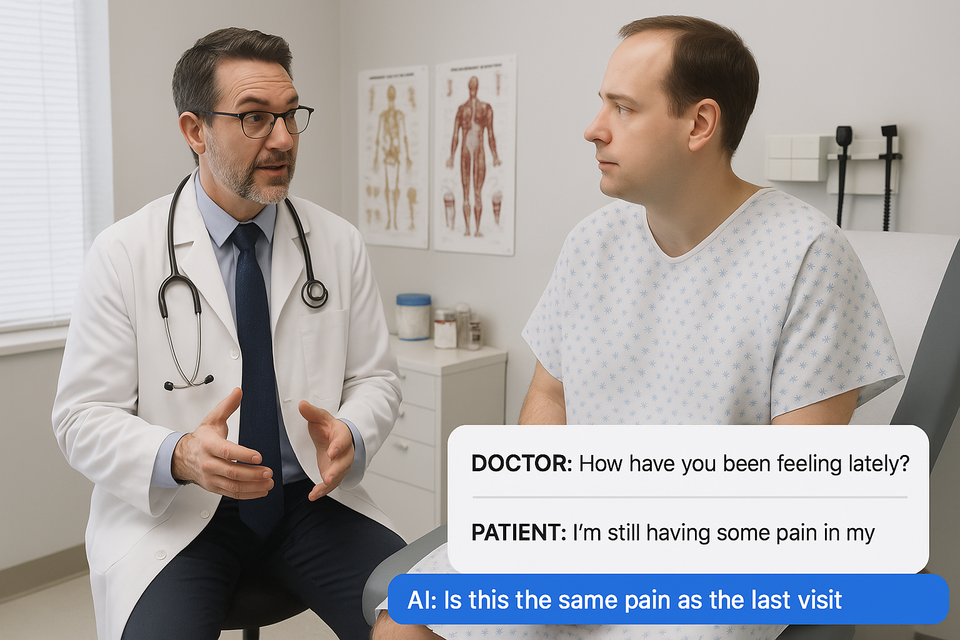WHY PATIENTS PREFER BOTS OVER DOCTORS AND WHAT HEALTHCARE LEADERS MUST DO NOW

WHY ARE PATIENTS TURNING TO AI CHATBOTS OVER DOCTORS?
If you’re here, you’re probably wondering: Why are patients suddenly preferring AI chatbots over real doctors? Maybe you’re a healthcare leader worried about patient engagement, a clinician frustrated by endless paperwork, or a patient curious if chatbots can really replace human care.
You might be searching for answers about AI in healthcare communication, how chatbots impact patient trust, or what this shift means for the future of medicine.
Here’s the surprising truth: many patients now say they get clearer, faster, and even more empathetic responses from AI chatbots than from their own doctors.
A recent healthcare executive admitted his patients preferred the chatbot because it responded immediately, remembered past conversations, and explained things in plain language—something his overworked doctors struggled to do.
And it’s not just patients who notice.
A major JAMA Internal Medicine study found healthcare professionals themselves preferred chatbot responses over physician replies nearly 80% of the time.
This isn’t just about technology outpacing tradition. It’s about a communication crisis in healthcare—and how AI chatbots might be the unexpected solution.
If you want to understand why this is happening, what it means for your organization, and how to adapt, you’re in the right place.
IMPORTANT POINTS
- Patients increasingly prefer AI chatbots because they provide immediate, clear, and empathetic communication.
- Physician-patient communication is breaking down because of administrative overload, time constraints, and documentation demands.
- Familiar, consumer-style chatbot interfaces reduce patient anxiety and build trust faster than traditional portals.
- AI chatbots outperform doctors in clarity, empathy, and accessibility, especially during off-hours.
- Trust in healthcare chatbots is driven by design familiarity and real-time responsiveness.
- Healthcare leaders can use frameworks like CARE to integrate AI chatbots effectively, improving patient engagement and reducing no-shows.
- The future of healthcare communication blends AI efficiency with human empathy, not one replacing the other.
THE COMMUNICATION CRISIS IN HEALTHCARE: WHY PATIENTS FEEL IGNORED
Let’s be honest: healthcare communication is broken.
Since COVID-19, the number of patient messages has jumped by 1.6 times, adding roughly 2.3 minutes per message to a doctor’s already packed day. That might sound minor, but multiply it by hundreds of messages, and it’s no wonder doctors feel overwhelmed.
Physicians now spend over a third of their face-to-face time on documentation instead of actually talking with patients. This split focus means patients see their doctor’s body in the room but not their full attention. It’s like talking to someone who’s texting during your conversation—you don’t feel heard.

This distraction damages non-verbal communication too. When doctors glance back and forth between screens and patients, they miss subtle cues: confusion, anxiety, hesitation. Patients may not realize their doctor understands or cares, leading to frustration and mistrust.
Time pressure only makes things worse.
Appointments were already short before the pandemic. Now, doctors juggle even more paperwork, leaving even less time for meaningful conversations. The result? Patients leave confused about their diagnosis or treatment, which leads to poor adherence.
As one doctor put it, “Some patients ignore follow-ups or don’t take medications properly.” Often, it’s not because they don’t care—it’s because they didn’t fully understand.
Patients who feel their doctor is distracted report lower satisfaction, less trust, and are less likely to follow advice. This creates a vicious cycle: poor communication leads to worse outcomes, which adds more administrative work, which further strains communication.
Meanwhile, patients’ expectations have changed.
They’re used to instant, personalized responses from banks, retailers, and airlines. When healthcare can’t match that, it feels outdated and unresponsive.
So, can technology fix the problem it partly caused? Surprisingly, yes.
AI chatbots, free from documentation burdens and time limits, can focus entirely on patient communication. They provide immediate, simple explanations in plain language—precisely where traditional healthcare often falls short.
JAKOB’S LAW: HOW FAMILIAR DESIGN MAKES CHATBOTS FEEL TRUSTWORTHY
Here’s a twist: patients aren’t just tolerating chatbots—they often prefer them. Why? Because the best healthcare chatbots don’t feel foreign. They feel familiar, like texting a friend or chatting with customer service on Amazon.
Jakob’s Law, which says people prefer systems that work like ones they already know, explains this. When a healthcare chatbot looks and feels like WhatsApp or Facebook Messenger, patients don’t have to learn anything new. Their brains can focus on their health, not on figuring out confusing menus.
This is especially important when patients are stressed, sick, or anxious. Familiar interfaces reduce mental effort, making it easier to ask questions and absorb information.
Imagine an elderly patient with diabetes. Faced with a clunky, unfamiliar portal, they might give up. But if the chatbot feels like texting their grandchild, they’re more likely to engage.
Research backs this up.
Older adults using familiar chatbot designs report surprisingly low mental strain. They find these tools accessible, even if they’re not tech-savvy. Familiarity acts like a comfort blanket, lowering anxiety and encouraging honest conversations.
The numbers tell the story: the healthcare chatbot market is booming, expected to triple by 2030. North America leads the way, holding nearly 40% of the market. When chatbots use familiar design elements—like Amazon-style progress bars—patient anxiety drops by over 40%.
As patients get used to these experiences, they expect healthcare to be as easy and responsive as their favorite apps.
This shift is forcing traditional healthcare to rethink how it communicates.
THE EXPERIENCE GAP: WHY CHATBOTS OUTPERFORM DOCTORS IN COMMUNICATION
That JAMA study I mentioned earlier? It found that healthcare professionals preferred chatbot responses nearly 80% of the time. Why? Because chatbots gave clearer, more thorough, and even more empathetic answers than doctors.
Think about Maria, a single mom who felt sick late at night. “I couldn’t wait until morning,” she said. The chatbot asked her the right questions, reassured her it wasn’t an emergency, and told her what to do next. No waiting, no judgment, just help when she needed it.
This 24/7 availability is a fundamental change.
Unlike doctors tied to office hours, chatbots are always on. Data shows that most mental health chatbot conversations happen late at night or on weekends—times when traditional care is unavailable. The longest, most meaningful chats often occur between 2 and 5 AM, when patients feel vulnerable and alone.
During these moments, patients open up about sensitive issues they might hesitate to discuss face-to-face. The chatbot becomes a safe space, free from judgment or time pressure.
Modern chatbots understand natural language, whether its medical jargon or everyday slang. They can detect urgency or distress and adjust their responses. Voice-enabled chatbots make this even more accessible for elderly patients or those with disabilities.
Some chatbots now recognize emotional cues and respond with empathy. Patients often say these bots feel more caring than rushed doctors. After experiencing this, many wonder why traditional healthcare can’t be as responsive or understanding.
This shift is widening the gap between what patients expect and what traditional healthcare delivers. And it’s pushing the industry to catch up.
THE PSYCHOLOGY OF TRUST: WHY PATIENTS BELIEVE IN CHATBOTS
Trust is everything in healthcare.
Studies show that about 75% of whether a patient follows treatment depends on how much they trust their provider.
Without trust, adherence drops, and outcomes suffer.
Historically, patients were wary of digital health tools. They worried about losing the human touch or about errors. Doctors worried about this too. That’s why healthcare lagged other industries in adopting digital communication.
But something interesting happened.
Patients began transferring trust from familiar consumer apps to healthcare tools that looked and felt similar.
This trust transfer happens because familiar designs reduce mental effort. Patients can focus on their health, not on learning a new system. They feel more confident, ask better questions, and remember more.
Familiar patterns trigger positive feelings from experiences. When patients navigate easily, they feel capable.
This builds trust quickly.
Chatbots also gather real-time feedback, constantly improving their responses. Unlike traditional systems that update quarterly, chatbots learn from every interaction, refining their communication.
This shift changes the patient-provider relationship.
Patients now expect healthcare to be as responsive and personalized as their favorite apps. But there’s a risk: patients might trust chatbots too much, overestimating their abilities just because they feel familiar.
Healthcare leaders need to balance this carefully.
PRACTICAL STRATEGIES: HOW HEALTHCARE LEADERS CAN USE AI CHATBOTS EFFECTIVELY
So, how can healthcare organizations harness these insights? Stanford’s 2025 pilot program offers a roadmap. By using AI schedulers, they cut patient no-shows by 41%. The secret? Applying psychological principles strategically.
One approach is the CARE framework:
- Context-aware AI: Understands patient history and preferences to personalize communication.
- Augmented decision-making: Supports, not replaces, clinical expertise.
- Responsiveness matching: Meets patient expectations for quick replies.
- Empathy metrics: Measures emotional connection, not just clinical outcomes.
Stanford’s program uses chatbots before, during, and after visits. Before appointments, chatbots prep patients. Afterward, they summarize the key points. Between visits, they check in. This creates a continuous communication loop, unlike traditional care that stops between appointments.
Design matters too.
Chatbots that mimic WhatsApp or Telegram reduce first-time user anxiety by over a third. For example, a 72-year-old patient rescheduled an appointment, checked medications, and reviewed instructions—all in three clicks. Previously, this took multiple calls and paperwork.
Applying the “3-click rule” helps. High-value tasks like medication reminders or symptom reporting should be doable in three steps. This boosts engagement, especially among older adults.
Empathetic language is crucial.
Instead of blunt instructions, chatbots that acknowledge challenges (“I know checking glucose four times a day is tough”) increase adherence by 22%.
Patients feel heard, even when talking to AI.
Managing information overload is another key. Use layered explanations: start simple, then offer more details if asked. Show only relevant options based on patient data. Release post-visit info gradually, so patients aren’t overwhelmed.
Advanced chatbots adjust tone and pacing based on patient emotions. If stress is detected, they slow down and use more formal language. For serious news, they add a brief pause to show care.
In this model, doctors become conductors, orchestrating AI tools to handle routine tasks while focusing on complex care and emotional support.
It’s not about replacing doctors—it’s about freeing them to do what only humans can.
THE FUTURE OF HEALTHCARE COMMUNICATION IS HUMAN + AI
We’re at a turning point.
Patients want healthcare that’s immediate, clear, and empathetic. Right now, AI chatbots often deliver that better than traditional systems. But the real opportunity isn’t choosing between humans and machines—it’s combining their strengths.
As Stanford’s results show, blending AI efficiency with human empathy leads to better engagement, fewer no-shows, and improved outcomes. The future belongs to healthcare teams that use AI to handle routine communication, freeing doctors to focus on complex care and building relationships.
For healthcare leaders, the message is simple: adapt now or risk falling behind.
Patients’ expectations have changed, and so must our approach to communication.

Member discussion